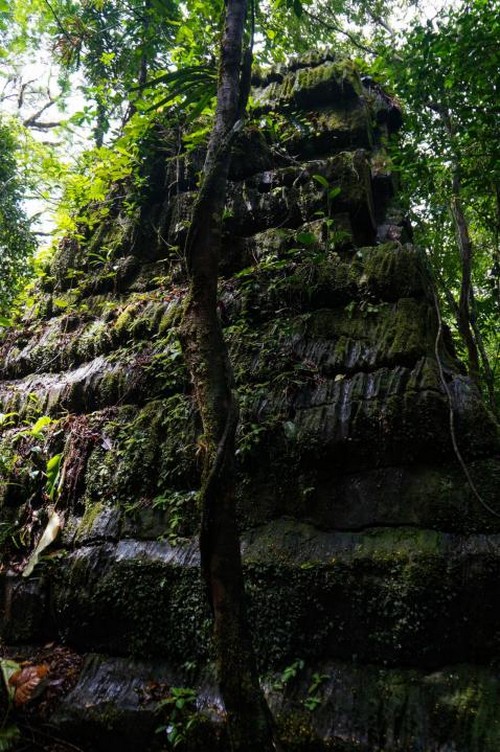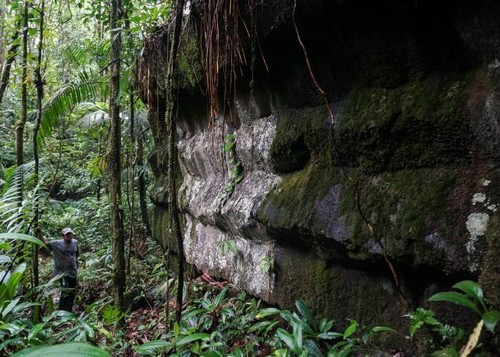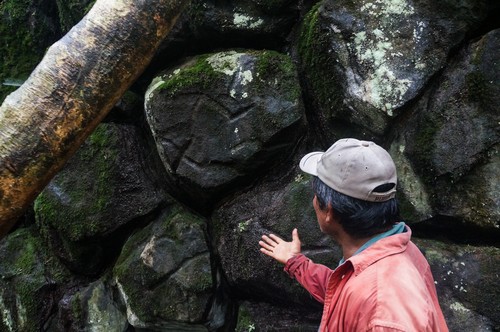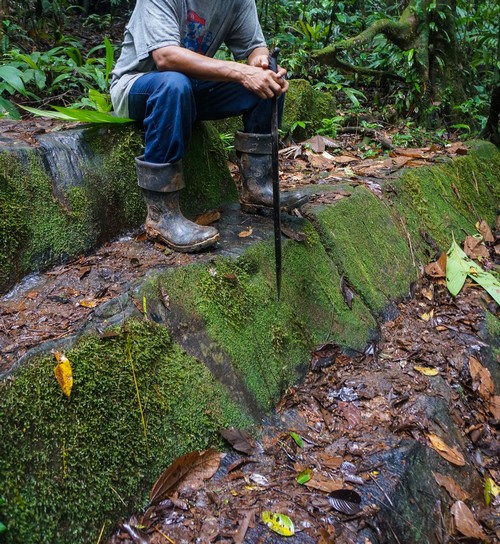It looks like you're using an Ad Blocker.
Please white-list or disable AboveTopSecret.com in your ad-blocking tool.
Thank you.
Some features of ATS will be disabled while you continue to use an ad-blocker.
share:
Good Day All.
As always I apologize for not being able to past the pics, this looks like a lost civilization that MAY actually seem legit. What do you all think?
www.bizarreglobehopper.com...
www.sciences-fictions-histoires.com...
The Pyramids of the Rama people in Nicaragua. I have never heard of Nicaraguan pyramids, and researching other sources does not get you much, but they certainly look real, or at least to carved. They also get a mention here, although not exactly a scientific article:
www.escapehere.com...
What do we think?
As always I apologize for not being able to past the pics, this looks like a lost civilization that MAY actually seem legit. What do you all think?
www.bizarreglobehopper.com...
www.sciences-fictions-histoires.com...
The Pyramids of the Rama people in Nicaragua. I have never heard of Nicaraguan pyramids, and researching other sources does not get you much, but they certainly look real, or at least to carved. They also get a mention here, although not exactly a scientific article:
www.escapehere.com...
What do we think?
a reply to: cachibatches
Ye should post some of those pics and give a bit more explanation
T'would improve your thread
Some nice pics there!
Ye should post some of those pics and give a bit more explanation
T'would improve your thread
Some nice pics there!
Not directly related, but apparently there is another pyramid find in Nicaragua:
ni.geoview.info...
www.facebook.com...
ni.geoview.info...
www.facebook.com...
edit on 1-7-2017 by cachibatches because: mispelled word
a reply to: cachibatches
Here go some pics for those who'd like to see the source material inside this thread:




Source
Here go some pics for those who'd like to see the source material inside this thread:




Source
My best guess, ancient giant petrified pineapple.
Never seen nature make something like that..
Never seen nature make something like that..
edit on 1-7-2017 by booyakasha because: (no reason given)
t would be interesting if they found carvings, engraving, any type of petroglyphs. They are usually common in the Yucatan. Very interesting find.
They liked to build with rocks long ago. I guess they invented the story of the three little pigs.
a reply to: cachibatches
It's clearly columnar jointed basalt which doesn't mean we're not looking at a manmade structure — think Nan Madol — but the joints lead me to believe it's not. I'd say look around the area, it could be a chunk that broke off an outcropping at a higher elevation.
It's clearly columnar jointed basalt which doesn't mean we're not looking at a manmade structure — think Nan Madol — but the joints lead me to believe it's not. I'd say look around the area, it could be a chunk that broke off an outcropping at a higher elevation.
a reply to: cachibatches
Clearly legit
Ancient Civilization Found in Nicaragua
The complex society existed before the Maya to the north. Its location in a tropical forest is surprising, experts say.
June 01, 2003|Thomas H. Maugh II | Times Staff Writer
articles.latimes.com...
Clearly legit
Ancient Civilization Found in Nicaragua
The complex society existed before the Maya to the north. Its location in a tropical forest is surprising, experts say.
June 01, 2003|Thomas H. Maugh II | Times Staff Writer
What Gassiot and his colleagues from Barcelona and the National Autonomous University of Nicaragua found at Kukra Hill were three large pyramid-like platforms, each about 20 to 25 feet high, surrounding a large central plaza -- an arrangement that is characteristic of cities throughout the region. Unlike the stone pyramids that were built by the Maya, however, the mounds were largely piles of earth, stone and rubble.
Surrounding the plaza, the team has so far discovered the remains of 22 other large buildings, but their survey has been limited by the dense vegetation. "That is not all of the buildings," Gassiot said. "We think it was much bigger."
They have also identified several small settlements surrounding the area that were probably dependent on the city.
A large circular formation, about 1,000 yards in diameter, may be a burial site, but the team has not yet had time to study it.
Near the plaza is what appears to be a storage area for basalt columns, each about nine feet long, that were made or found elsewhere and brought to Cascal for storage.
"The columns resemble those found at Mexican sites, where they had ritual uses," Gassiot said. Similar columns occur naturally at La Venta near Veracruz Mexico, where they are produced by natural volcanic activity. They were used at La Venta to mark burial sites.
articles.latimes.com...
a reply to: theantediluvian
This is pretty old news actually, I think from '02 or '03. Seaworthy beat me to it and posted the article I remembered reading when it first came out. This is a legit site, Pre Maya and Pre Rama.
This is pretty old news actually, I think from '02 or '03. Seaworthy beat me to it and posted the article I remembered reading when it first came out. This is a legit site, Pre Maya and Pre Rama.
originally posted by: SeaWorthy
a reply to: cachibatches
Clearly legit
Ancient Civilization Found in Nicaragua
The complex society existed before the Maya to the north. Its location in a tropical forest is surprising, experts say.
June 01, 2003|Thomas H. Maugh II | Times Staff Writer
What Gassiot and his colleagues from Barcelona and the National Autonomous University of Nicaragua found at Kukra Hill were three large pyramid-like platforms, each about 20 to 25 feet high, surrounding a large central plaza -- an arrangement that is characteristic of cities throughout the region. Unlike the stone pyramids that were built by the Maya, however, the mounds were largely piles of earth, stone and rubble.
Surrounding the plaza, the team has so far discovered the remains of 22 other large buildings, but their survey has been limited by the dense vegetation. "That is not all of the buildings," Gassiot said. "We think it was much bigger."
They have also identified several small settlements surrounding the area that were probably dependent on the city.
A large circular formation, about 1,000 yards in diameter, may be a burial site, but the team has not yet had time to study it.
Near the plaza is what appears to be a storage area for basalt columns, each about nine feet long, that were made or found elsewhere and brought to Cascal for storage.
"The columns resemble those found at Mexican sites, where they had ritual uses," Gassiot said. Similar columns occur naturally at La Venta near Veracruz Mexico, where they are produced by natural volcanic activity. They were used at La Venta to mark burial sites.
articles.latimes.com...
Excellent! Thanks.
Given how poor Nicaragua is I wonder someone couldn't start a movement to get this excavated so they get some tourist money.
originally posted by: peter vlar
a reply to: theantediluvian
This is pretty old news actually, I think from '02 or '03. Seaworthy beat me to it and posted the article I remembered reading when it first came out. This is a legit site, Pre Maya and Pre Rama.
Colmnar basalt storage piles though, not pyramids. So the ultimate answer to the OP's title question is "No."
Harte
originally posted by: Harte
originally posted by: peter vlar
a reply to: theantediluvian
This is pretty old news actually, I think from '02 or '03. Seaworthy beat me to it and posted the article I remembered reading when it first came out. This is a legit site, Pre Maya and Pre Rama.
Colmnar basalt storage piles though, not pyramids. So the ultimate answer to the OP's title question is "No."
Harte
There is a lot more to it than that, though. It is a definite site, and even those columns may have had ritual use.
From the article:
What Gassiot and his colleagues from Barcelona and the National Autonomous University of Nicaragua found at Kukra Hill were three large pyramid-like platforms, each about 20 to 25 feet high, surrounding a large central plaza -- an arrangement that is characteristic of cities throughout the region. Unlike the stone pyramids that were built by the Maya, however, the mounds were largely piles of earth, stone and rubble. Surrounding the plaza, the team has so far discovered the remains of 22 other large buildings, but their survey has been limited by the dense vegetation. "That is not all of the buildings," Gassiot said. "We think it was much bigger." They have also identified several small settlements surrounding the area that were probably dependent on the city. A large circular formation, about 1,000 yards in diameter, may be a burial site, but the team has not yet had time to study it. Near the plaza is what appears to be a storage area for basalt columns, each about nine feet long, that were made or found elsewhere and brought to Cascal for storage. "The columns resemble those found at Mexican sites, where they had ritual uses," Gassiot said. Similar columns occur naturally at La Venta near Veracruz Mexico, where they are produced by natural volcanic activity. They were used at La Venta to mark burial sites.
originally posted by: cachibatches
originally posted by: Harte
originally posted by: peter vlar
a reply to: theantediluvian
This is pretty old news actually, I think from '02 or '03. Seaworthy beat me to it and posted the article I remembered reading when it first came out. This is a legit site, Pre Maya and Pre Rama.
Colmnar basalt storage piles though, not pyramids. So the ultimate answer to the OP's title question is "No."
Harte
There is a lot more to it than that, though. It is a definite site, and even those columns may have had ritual use.
It's a sure thing that the columns had some sort of use. They wouldn't be there if not.
But those are not pyramids.
Isn't that what the thread asked?
Harte
originally posted by: Harte
originally posted by: cachibatches
originally posted by: Harte
originally posted by: peter vlar
a reply to: theantediluvian
This is pretty old news actually, I think from '02 or '03. Seaworthy beat me to it and posted the article I remembered reading when it first came out. This is a legit site, Pre Maya and Pre Rama.
Colmnar basalt storage piles though, not pyramids. So the ultimate answer to the OP's title question is "No."
Yeah, but I'll take a mere lost city.
Harte
There is a lot more to it than that, though. It is a definite site, and even those columns may have had ritual use.
It's a sure thing that the columns had some sort of use. They wouldn't be there if not.
But those are not pyramids.
Isn't that what the thread asked?
Harte
Yeah, but I'll take a mere lost city.
edit on 2-7-2017 by cachibatches because: can't find my response.
originally posted by: cachibatches
originally posted by: Harte
originally posted by: cachibatches
originally posted by: Harte
originally posted by: peter vlar
a reply to: theantediluvian
This is pretty old news actually, I think from '02 or '03. Seaworthy beat me to it and posted the article I remembered reading when it first came out. This is a legit site, Pre Maya and Pre Rama.
Colmnar basalt storage piles though, not pyramids. So the ultimate answer to the OP's title question is "No."
Yeah, but I'll take a mere lost city.
Harte
There is a lot more to it than that, though. It is a definite site, and even those columns may have had ritual use.
It's a sure thing that the columns had some sort of use. They wouldn't be there if not.
But those are not pyramids.
Isn't that what the thread asked?
Harte
Yeah, but I'll take a mere lost city.
No doubt there are many more unknown settlements in Mesoamerica and South America.
Probably many more undiscovered pyramids as well.
Harte
edit on 7/3/2017 by Harte because: of the wonderful things he does!
a reply to: Harte
Personally, I thought it was pretty fascinating that there was an urban center being developed that deep into the jungles of the Yucatán at a time and especially, a place, where nobody thought it was likely to exist. Based on my own travels in the area, it's not the most hospitable of places to set up shop.
Personally, I thought it was pretty fascinating that there was an urban center being developed that deep into the jungles of the Yucatán at a time and especially, a place, where nobody thought it was likely to exist. Based on my own travels in the area, it's not the most hospitable of places to set up shop.
originally posted by: peter vlar
a reply to: Harte
Personally, I thought it was pretty fascinating that there was an urban center being developed that deep into the jungles of the Yucatán at a time and especially, a place, where nobody thought it was likely to exist. Based on my own travels in the area, it's not the most hospitable of places to set up shop.
I've never been there.
You could probably say the same about a lot of the lost cities that have been found down there though.
Most lost to smallpox, I'd say.
Harte
new topics
-
What Comes After January 20th
Mainstream News: 50 minutes ago -
Canada as a state .. how would it work?
General Chit Chat: 59 minutes ago -
Those stupid GRAVITE commercials
Rant: 1 hours ago -
Let's Buy Greenland
General Chit Chat: 2 hours ago -
Planned Civil War In Britain May Be Triggered Soon
Social Issues and Civil Unrest: 5 hours ago -
Claim: General Mark Milley Approved Heat and Sound Directed Energy Weapons During 2020 Riots
Whistle Blowers and Leaked Documents: 7 hours ago
top topics
-
Claim: General Mark Milley Approved Heat and Sound Directed Energy Weapons During 2020 Riots
Whistle Blowers and Leaked Documents: 7 hours ago, 11 flags -
Planned Civil War In Britain May Be Triggered Soon
Social Issues and Civil Unrest: 5 hours ago, 5 flags -
Let's Buy Greenland
General Chit Chat: 2 hours ago, 4 flags -
What Comes After January 20th
Mainstream News: 50 minutes ago, 4 flags -
Those stupid GRAVITE commercials
Rant: 1 hours ago, 2 flags -
Canada as a state .. how would it work?
General Chit Chat: 59 minutes ago, 1 flags
active topics
-
The Truth about Migrant Crime in Britain.
Social Issues and Civil Unrest • 32 • : gortex -
ILLUMINATION: Dimensions / Degrees – Da Vincis Last Supper And The Philosophers Stone
Secret Societies • 13 • : McTech2 -
What Comes After January 20th
Mainstream News • 5 • : chiefsmom -
Claim: General Mark Milley Approved Heat and Sound Directed Energy Weapons During 2020 Riots
Whistle Blowers and Leaked Documents • 22 • : BeyondKnowledge3 -
Let's Buy Greenland
General Chit Chat • 12 • : CriticalStinker -
-@TH3WH17ERABB17- -Q- ---TIME TO SHOW THE WORLD--- -Part- --44--
Dissecting Disinformation • 3955 • : Thoughtful3 -
Those stupid GRAVITE commercials
Rant • 3 • : Cre8chaos79 -
Canada as a state .. how would it work?
General Chit Chat • 5 • : CriticalStinker -
Gravitic Propulsion--What IF the US and China Really Have it?
General Conspiracies • 30 • : Lazy88 -
Remember These Attacks When President Trump 2.0 Retribution-Justice Commences.
2024 Elections • 133 • : Oldcarpy2
